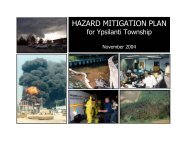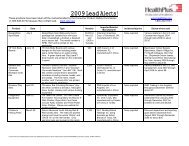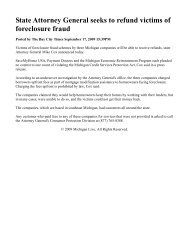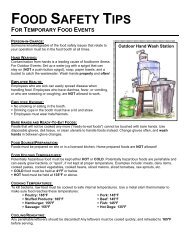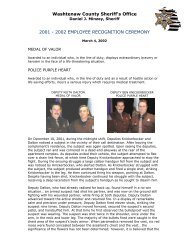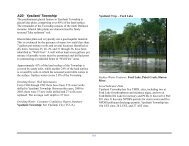Water Protection Activities in Washtenaw County
Water Protection Activities in Washtenaw County
Water Protection Activities in Washtenaw County
You also want an ePaper? Increase the reach of your titles
YUMPU automatically turns print PDFs into web optimized ePapers that Google loves.
Challenge # 13 Temperature, Volume and Rate<br />
The source of high surface water temperatures can be traced to<br />
impervious surfaces, land clear<strong>in</strong>g, land use alterations and soil<br />
compaction. Impervious and compacted surfaces prevent<br />
ra<strong>in</strong>fall and snowmelt from percolat<strong>in</strong>g <strong>in</strong>to the ground.<br />
Instead, storm water accumulates and is discharged off-site as<br />
surface runoff. This fundamentally alters the balance between<br />
surface and ground water feed<strong>in</strong>g lakes and streams.<br />
Groundwater enters streams at a relatively constant<br />
temperature (between 49 and 54 degrees Fahrenheit) regardless<br />
of the season. Surface water is much closer to the ambient air<br />
temperature. As a watershed develops, its lakes and streams<br />
receive a much greater proportion of warm surface water<br />
runoff, and less cold groundwater. Higher summer<br />
temperatures alter <strong>in</strong>-stream habitat for fish, <strong>in</strong>vertebrates and<br />
other aquatic life. Not only is the water warmer, but also its<br />
capacity to store oxygen is lower. As temperatures rise,<br />
sensitive species, those not able to adapt to their warmer<br />
environment, decl<strong>in</strong>e and disappear altogether.<br />
Excessive flow and volume issues can also be traced to<br />
impervious surfaces, land clear<strong>in</strong>g, land use alterations and soil<br />
compaction. Precipitation prevented from percolat<strong>in</strong>g <strong>in</strong>to the<br />
soil accumulates and is discharged as surface water runoff. As<br />
a creekshed develops, runoff volumes <strong>in</strong>crease and water is<br />
delivered to receiv<strong>in</strong>g waters at a much faster rate. The<br />
cumulative impact of urban development throughout the<br />
watershed can be measured <strong>in</strong> the receiv<strong>in</strong>g waterways. Instream<br />
hydraulics and stream channel structure, or<br />
morphology, are altered <strong>in</strong> fundamental ways.<br />
Temperature, Volume, and Rate Response Objective:<br />
M<strong>in</strong>imize behaviors and activities that <strong>in</strong>crease the volume and<br />
velocity of storm water runoff and create negative impacts on<br />
the aquatic life and habitat <strong>in</strong> <strong>Washtenaw</strong> <strong>County</strong>.<br />
54<br />
Temperature, Volume, and Rate Response Assessment:<br />
Most urban streams and many urbaniz<strong>in</strong>g streams show the<br />
negative impacts of <strong>in</strong>creased flows. The Adopt-a-Stream<br />
program is conduct<strong>in</strong>g some monitor<strong>in</strong>g for flow; the<br />
rema<strong>in</strong>der is be<strong>in</strong>g conducted with<strong>in</strong> the scope of specific<br />
projects. No trend <strong>in</strong>formation is available. However, it is<br />
realistic to assume that the<br />
rapid <strong>in</strong>crease <strong>in</strong> impervious<br />
surface <strong>in</strong> the county is<br />
unlikely to be fully mitigated<br />
by current BMPs. Site<br />
design and storm water<br />
management standards that<br />
better mimic natural systems<br />
must be put <strong>in</strong>to place at an<br />
accelerated pace. We have<br />
little local data regard<strong>in</strong>g the<br />
effectiveness of our current<br />
BMPs.<br />
What protection activities<br />
address the challenge<br />
of temperature, volume<br />
and rate?<br />
Michigan Dra<strong>in</strong> Code<br />
<strong>Water</strong>shed Management<br />
Plann<strong>in</strong>g<br />
Local Ord<strong>in</strong>ances<br />
Open Space Acquisition<br />
NREPA<br />
The <strong>County</strong> Dra<strong>in</strong> Commissioner’s Rules (design standards)<br />
set specific temperature criteria for certa<strong>in</strong> watersheds when<br />
thermal impacts are of paramount concern. New standards will<br />
also promote the <strong>in</strong>filtration of smaller storm events, and are<br />
expected to substantially improve stream channel protection.<br />
The rules also control the rate of storm water flow from all new<br />
developments. More aggressive approaches to low impact<br />
development are needed through local plann<strong>in</strong>g, zon<strong>in</strong>g, and<br />
site design criteria.



